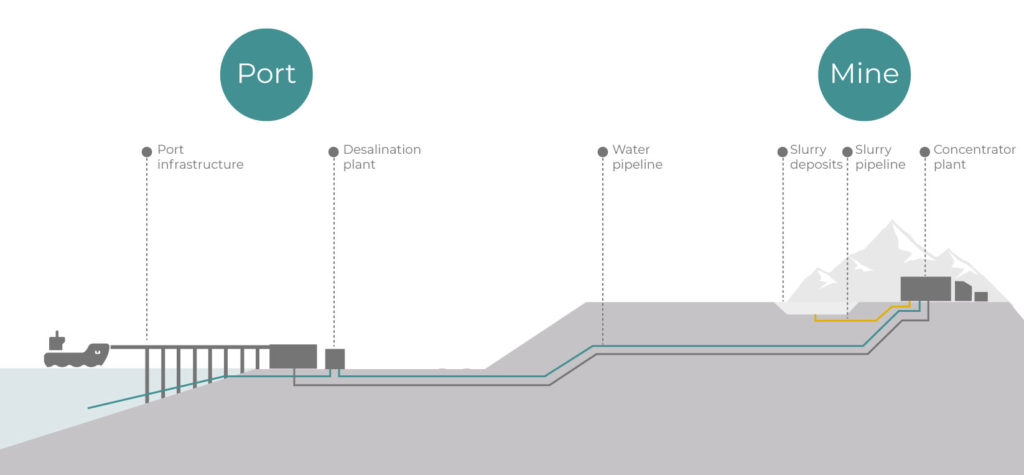Mining in Latin America is a large scale, well established activity, Atmos International Sales Engineer, Rodrigo Salgado, writes. Latin America accounts for 50% of the world’s silver production, 40% of the global production of copper and 35% of the world’s lithium.¹

Figure 1: Latin America’s shares in the production of selected minerals
With the region holding a significant share in the production and reserves of the world’s minerals, mining has historically made up between 13% and 19% of Latin America’s direct investment from foreign territories and mining consistently remains a focal part of the economy in the region, but at what cost?
This article looks at the human involvement in Latin American mining and slurry pipeline operations, from the humans impacted by mining operations to the humans who are instrumental in providing vital leak detection support.
Social responsibility challenges facing Latin American mining companies
The ethics of desalination
A substantial amount of water is used every day to sustain the Latin American mining industry’s operational processes, whether that be for mineral processing, separation and extraction, or to facilitate the transportation of ores across long distances in slurry pipelines.² The mining industry requires uncontaminated water too, so it’s also worth noting that desalinated water is often used to support mining operations, a process which can involve many methods.
The most common method for desalination in the mining industry is via reverse osmosis, which requires seawater to pass over a membrane under high pressure conditions to filter out the minerals and other contaminants, creating desalinated water.³

A water supply imbalance
The high quantity and quality of water required by the Latin American mining industry today is occurring at the same time widespread water shortages in residential areas are being observed. For example, the Chilean mining industry consumes an annual amount of water that could sustain 75% of its population’s needs,4 with Brazil using 1.6% of the country’s total water supply for mining which could supply the entirety of Brazil’s rural population with water, according to Salgado.
The Latin American water supply imbalance has led to many conflicts, with data from the Pastoral Land Commission indicating that 124 out of 197 recorded water-related conflicts in Brazil have occurred in areas where mining ore extraction routinely takes place,5 and this imbalance has only been worsened by the COVID-19 pandemic.
The hygiene concerns caused by the pandemic meant access to safe water in hospitals, for general handwashing and in the production of alcohol in hand gel, had never been more important, especially considering the fact that at least 65 million people in Latin America had no access to soap and water.6
Consequences and considerations
With almost 55 million indigenous men and women representing 8.5% of the Latin American population7, another social issue facing mining is related to pipeline operations that infringe on indigenous people’s territories.
Just as a leak or rupture in mining operations has the potential to devastate indigenous communities, there is also a high risk to more densely populated areas, such as urban locations or locations containing wildlife. With a population density of 57 per sq.km and a rainforest that covers approximately 40% of the region containing endangered species,8 an effective leak detection system is vital for mining and slurry pipeline operations in Latin America.
The humans behind mining pipeline leak detection
Effective leak detection in the Latin American mining industry starts with water management, not only because ore extraction can contain high traces of pollutants,9 but because there are many threats to pipeline integrity in Latin America such as landslides, lahars, riverbed scour and underground erosion.
Solutions like Atmos Pipe can provide statistical volume balance analysis to detect new and existing leaks while Atmos Wave Flow can use volume balance and negative pressure wave methods for fast and accurate leak detection with high sensitivity and a low false alarm rate.
To ensure a mining and slurry operation continues to run at its optimum level, introducing the human element ensures ongoing monitoring of the pipeline, product and activity by experienced engineers who are trained to recognise unusual behaviour, Salgado says.
A batch can include batches of different products or batches of the same product but different quality, so it’s not uncommon for different batches to move through the pipeline in a mining and slurry operation, especially considering the amount of water used in a mining pipeline to transport ores. Atmos Batch is a real time batch tracking solution that enables operators to know the head and tail location of every batch and its estimated time of arrival, reducing the risk of product contamination and supports with draining and filling operations, Salgado says.
In the face of US Federal regulations requiring a record of pipeline operator training and a plan for continuous performance improvement, Atmos Trainer, meanwhile, combines elements of Atmos SIM with a SCADA user interface to provide a pipeline training environment for the operator.
In the context of mining and slurry operations, the control system can be mimicked, allowing operators to control a virtual pipeline during normal and abnormal operating conditions. Platforming pipeline operators with the training environment to understand a pipeline’s behaviors can improve confidence, reduce the risk to a real mining and slurry operation and support compliance with regulations, according to Salgado.
5 https://www.sciencedirect.com/science/article/pii/S2214790X21001866
6 https://www.unesco.org/en/articles/waters-latin-america-and-caribbean-contributions-times-covid-19
7 https://www.ilo.org/global/about-the-ilo/newsroom/news/WCMS_864176/lang–en/index.htm
8 https://education.nationalgeographic.org/resource/south-america-physical-geography/



